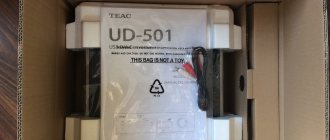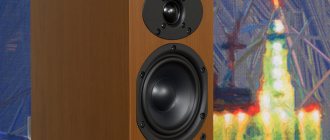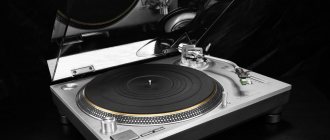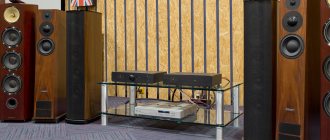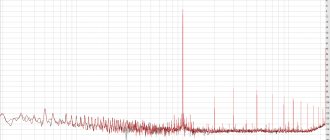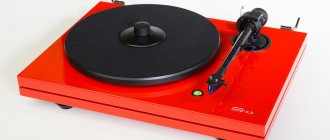Although today physical media have found themselves on the periphery, and one may get the feeling that only the spontaneous fashion for vinyl supports disc circulation, but in fact there are still many CD lovers and slightly fewer, but specifically audiophile-minded, SACD connoisseurs. Therefore, manufacturers continue to produce serious and very expensive devices. However, in this test the SACD/CD player is only half of a pair, and the amplifier, as it should be today, is a full-fledged player in itself.
Formats and capabilities
Denon's new components are numbered 1600, and any four-digit index in the company's Hi-Fi component designation automatically places them in the highest category. The DCD-1600NE player is designed to play CDs and SACDs. In addition, it is capable of playing Hi-Res files recorded on DVD media. Supports WAV up to 24-bit/192 kHz, ALAC up to 24-bit/96 kHz and DSD files up to 5.6 MHz.
The lack of support for the more common FLAC format, and the very fact of using blanks as an intermediary between the computer and the player, will significantly complicate the use of the DCD-1600NE with anything other than CD and SACD. But what is not so conveniently implemented in the player can be found in the PMA-1600NE amplifier. The built-in USB DAC accepts PCM streams up to 32 bit/384 kHz and DSD up to 11.2 MHz. In a word, the system turned out to be classic only at first glance. In essence, it is quite modern.
This amplifier has tone settings and a mute button.
What follows is a very intricate logical chain of reasoning, so watch your hands carefully. If an amplifier is capable of reproducing Hi-Res of even higher quality than a SACD/CD player, why do you need the latter?
The first thing that can be assumed as a justification is the difference in hardware. Like the one when they put a better DAC in the player, and only a nominal one in the amplifier, as long as it works. But no. If you look at the specifications, the player and amplifier of the 1600 series use the same PCM1795 chip, jitter-free digital circuit topology DAC Master Clock Design, Advanced AL32 Processing Plus upsampling technology, and even the same Direct Mechanical Ground Construction housing design with mechanical decoupling of boards and blocks from each other to minimize vibration transmission. Thus, the quality of the digital part in both cases is actually the same, which means the assumption is incorrect.
SACD player looks laconic
What's the point of a record player then? Firstly, when it comes to reproducing original CDs and SACDs, it is quite possible that there will be a difference between the disc and the digital copy in favor of the former (since the CD-DA format does not have check bits and is copied only with varying degrees of reliability, and SACD is completely impossible to copy without intermediate conversions). But all this is controversial, especially since now you can find studio FLACs, which are in fact the source for printing CDs and SACDs.
The second argument is much more weighty: disks are still material media. They can be held in your hands, they have a cover and a booklet that you can read. In the end, any self-respecting audiophile has accumulated a considerable amount of these same discs, and throwing them all away at once and switching to listening to files will not raise their hand. Especially if you remember how much effort, time and money went into obtaining some English or Japanese first press...
Denon moves into a new era of digital hi-fi with the Denon PMA-1600NE amplifier with built-in USB DAC, and the Denon DCD-1600NE player with support for Super Audio CD and DSD formats
Eindhoven, 8 December 2016 – Denon, one of the world's leading manufacturers of high-quality hi-fi and home cinema systems, announces the launch of two new components in its home audio range, marking a new step into the world of digital audio. Now you can get studio quality sound in your home!
Building on the technology of the flagship PMA-2500NE amplifier and DCD-2500NE player released in 2016, the new Denon PMA-1600NE and Denon DCD-1600NE system offer a more affordable price and a great opportunity for true audio enthusiasts to play high-resolution audio from SACD or discs. directly from a personal computer.
The new models replace the popular 1520 line and are the result of more than 100 years of Denon audio engineering experience and the latest in high-resolution digital audio technology.
Integrated amplifier PMA-1600NE with built-in DAC
Denon is one of the few music brands that continues to actively develop hi-fi components, as well as develop and introduce new technologies.
The capabilities of the Denon PMA-1600NE amplifier go far beyond the limits set by the previous generation of PMA-1500 series amplifiers. Featuring a built-in USB port and a high-quality Digital-to-Analog Converter (DAC), the amplifier plays high-resolution music files up to 384 kHz/32-bit and DSD (up to 11.2MHz), allowing you to get impeccable sound from your computer. For better sound reproduction from analog inputs, the PMA-1600NE is equipped with a special Analog Mode, which turns off the power to the digital circuits and avoids any interference in the analog section of the amplifier.
The device uses a proprietary UHC (Ultra High Current)-MOS topology. It is made according to a push-pull circuit using powerful field-effect transistors capable of delivering high current to the load with minimal distortion. This circuit combines high output power with the ability to masterfully reproduce the full sonic range of any style, from the subtle musical nuances of jazz performers to the powerful climaxes of a symphony orchestra.
The PMA-1600NE amplifier chassis design consists of 6 independent blocks, separated by walls made of 1 mm thick steel plates, which protect electrical circuits from vibration and eliminate unfavorable mutual interference between blocks. The fastenings of the power transformer, radiators and block walls are made of ABS plastic, which absorbs vibration.
The digital section of the PMA-1600NE is based on Denon's renowned Advanced AL32 Plus technology, which uses unique data interpolation algorithms. These algorithms bring the resulting signal closer to the original analog audio by carefully restoring data that was lost during digital recording. As a result, the sound is reproduced in great detail, the sources are clearly localized in space, the sound is rich and expressive throughout the entire range and closely matches the original.
In order to accurately synchronize digital data streams, the DAC Master Clock clock generator synchronizes all components of the digital path from a single signal source and allows you to get rid of jitter. The location of the pulse generator directly next to the DAC made it possible to reduce the influence of vibrations and ensure unprecedentedly high fidelity of information transmission.
The PMA-1600NE also includes a phono stage that supports MM and MC cartridges. This phono preamplifier has high gain, and its “simple and direct” design allows sound to be transmitted without distortion. The PMA-1600NE features a relay-type MM/MC switch, which simplifies the PCB layout and reduces audio interference, allowing you to reproduce the most subtle nuances of music.
MAIN CHARACTERISTICS
- 2 x 140 W (4 ohms) Enough power even for large rooms
- Widest dynamic range, from deep bass to fine treble detail
- Reproduction of sound without distortion
- Enjoy sound without noise or interference from other system components
- Only the most necessary information
- For clear sound reproduction
- Play digital recordings as close to the original as possible
- Minimize any vibrations in the housing
- Eliminates interference and noise between circuits
- For the highest sound quality
- To play music from any source
Pairs perfectly with the DCD-1600NE Super Audio CD player and other Denon components.
Super Audio CD player DCD-1600NE with DSD support
When developing the DCD-1600NE, the goal was to achieve the highest parameters for a CD player: ultra-high precision disc reading and lossless sound transmission to the amplifier. The model's circuitry was designed from the ground up to keep the signal path as short as possible and ensure that the original sound is accurately reproduced by the system.
In addition to regular CDs, the player plays Super Audio CDs and PCM192/24 and DSD5.6 audio recorded on DVD-R/RW, giving you access to a world of high-resolution audio.
The drive design of the DCD-1600NE player is based on the SVH (Suppress Vibration Hybrid) mechanism. The loader uses the latest materials to reduce vibration in the mechanism. The result is an extremely vibration-resistant design and information from the disk is read with impeccable accuracy.
The DCD-1600NE digital block is equipped with two clock generators for standard sampling rates (44.1 kHz and 48 kHz), which completely eliminate jitter. The DAC's power supply has also been significantly improved. The highest quality capacitors were used in the circuit, resulting in very high performance and excellent transparent sound with a deep spatial stage.
Power supplies for digital and analog circuits have separate transformers to eliminate mutual interference and noise. As a result of this design, mutual interference between electrical circuits is practically eliminated, allowing you to obtain clean and transparent sound.
The PMA-1600NE and DCD-1600NE will be available in Premium Silver and Black from February 2022.
MAIN CHARACTERISTICS
- Advanced AL32 Plus processor and high-precision 192 kHz/32-bit DAC Digital recordings sound as close to the original as possible
- Audio reproduction without jitter or distortion
- Eliminate unwanted vibration
- For the highest sound quality
- Most accurate disk reading
- Support for modern High-Res Audio formats
- No interference or noise inside the player
- Reproducing sound without digital processing
- Pairs perfectly with the PMA-1600NE amplifier and other Denon components
The discs are spinning
There is one more argument in favor of the DCD-1600NE player: it is simply gorgeous. The tall body with an aluminum facade gives that very desirable feeling of owning High-End equipment. Its overall design is uncluttered and, apart from the playfully angled back edge, is a direct statement of minimalism. At the same time, a certain power and strength can be seen in the dimensions themselves, the quality of materials and the solidity of the design.
The 1600 series is the very upper segment of Hi-Fi that is almost High End
I have already talked about the design of the digital part in general, but it’s worth clarifying the details. The main technology of Advanced AL32 Plus is essentially an interpolation algorithm for a digital signal, when artificially increasing the bit depth and bit depth allows you to restore the original shape of the analog signal with higher accuracy. Master Clock Design technology involves using the DAC clock generator as the main one for the entire digital circuit, which allows you to get rid of the jitter that occurs in the digital part of any player. It is also noteworthy that for signal frequencies that are multiples of 44.1 kHz and 48 kHz, two different generators are used.
The symmetrically located disk drive is maximally protected from internal and external vibrations
It is also worth mentioning the proprietary disk drive with an SVH loader, which ensures high reading accuracy due to vibration damping. The circuit design uses the principles of minimizing the signal path. The power supplies for the digital and analog parts are separated to minimize interference. Clearer sound is promised in Pure Direct mode, which turns off unnecessary circuits, such as the device’s display.
Denon components test!
Test of the Denon PMA-1600NE amplifier and DCD-1600NE SACD/CD player: three buttons for purists.
Although today physical media have found themselves on the periphery and one may get the feeling that only the spontaneous fashion for vinyl supports disc circulation, in fact there are still many CD lovers and slightly fewer, but specifically audiophile-minded, SACD connoisseurs. Therefore, manufacturers continue to produce serious and very expensive devices. However, in this test the SACD/CD player is only half of a pair, and the amplifier, as it should be today, is a full-fledged player in itself.
Formats and capabilities
Denon's new components are numbered 1600, and any four-digit index in the company's Hi-Fi component designation automatically places them in the highest category. The DCD-1600NE player is designed to play CDs and SACDs. In addition, it is capable of playing Hi-Res files recorded on DVD media. Supports WAV up to 24-bit/192 kHz, ALAC up to 24-bit/96 kHz and DSD files up to 5.6 MHz.
The lack of support for the more common FLAC format, and the very fact of using blanks as an intermediary between the computer and the player, will significantly complicate the use of the DCD-1600NE with anything other than CD and SACD. But what is not so conveniently implemented in the player can be found in the PMA-1600NE amplifier. The built-in USB DAC accepts PCM streams up to 32 bit/384 kHz and DSD up to 11.2 MHz. In a word, the system turned out to be classic only at first glance. In essence, it is quite modern.
What follows is a very intricate logical chain of reasoning, so watch your hands carefully. If an amplifier is capable of reproducing Hi-Res of even higher quality than a SACD/CD player, why do you need the latter?
The first thing that can be assumed as a justification is the difference in hardware. Like the one when they put a better DAC in the player, and only a nominal one in the amplifier, as long as it works. But no. If you look at the specifications, the player and amplifier of the 1600 series use the same PCM1795 chip, jitter-free digital circuit topology DAC Master Clock Design, Advanced AL32 Processing Plus upsampling technology, and even the same Direct Mechanical Ground Construction housing design with mechanical decoupling of boards and blocks from each other to minimize vibration transmission. Thus, the quality of the digital part in both cases is actually the same, which means the assumption is incorrect.
What's the point of a record player then? Firstly, when it comes to reproducing original CDs and SACDs, it is quite possible that there will be a difference between the disc and the digital copy in favor of the former (since the CD-DA format does not have check bits and is copied only with varying degrees of reliability, and SACD is completely impossible to copy without intermediate conversions). But all this is controversial, especially since now you can find studio FLACs, which are in fact the source for printing CDs and SACDs.
The second argument is much more weighty: disks are still material media. They can be held in your hands, they have a cover and a booklet that you can read. In the end, any self-respecting audiophile has accumulated a considerable amount of these same discs, and throwing them all away at once and switching to listening to files will not raise their hand. Especially if you remember how much effort, time and money went into obtaining some English or Japanese first press...
The discs are spinning
There is one more argument in favor of the DCD-1600NE player: it is simply gorgeous. The tall body with an aluminum facade gives that very desirable feeling of owning High-End equipment. Its overall design is uncluttered and, apart from the playfully angled back edge, is a direct statement of minimalism. At the same time, a certain power and strength can be seen in the dimensions themselves, the quality of materials and the solidity of the design.
I have already talked about the design of the digital part in general, but it’s worth clarifying the details. The main technology of Advanced AL32 Plus is essentially an interpolation algorithm for a digital signal, when artificially increasing the bit depth and bit depth allows you to restore the original shape of the analog signal with higher accuracy. Master Clock Design technology involves using the DAC clock generator as the main one for the entire digital circuit, which allows you to get rid of the jitter that occurs in the digital part of any player. It is also noteworthy that for signal frequencies that are multiples of 44.1 kHz and 48 kHz, two different generators are used.
It is also worth mentioning the proprietary disk drive with an SVH loader, which ensures high reading accuracy due to vibration damping. The circuit design uses the principles of minimizing the signal path. The power supplies for the digital and analog parts are separated to minimize interference. Clearer sound is promised in Pure Direct mode, which turns off unnecessary circuits, such as the device’s display.
Analogue and digital
A special chip on the USB input provides galvanic isolation from a computer or laptop connected to the amplifier. The PCM 1795 DAC chip, built into the amplifier according to the passport, has a 32-bit capacity and a maximum frequency of 192 kHz. This means that 32/384 signals will be down-converted by frequency, while other common formats will be up-converted either by bit-width only or by both bit-width and frequency. Advanced AL32 Plus any signal results in a format that matches the maximum performance of the DAC.
All digital circuits are decoupled from analog and power supply. Analog Mode allows you to turn off all the “digital” in the amplifier, including the display, i.e. switches the amplifier into the mode of a regular analog device, which eliminates possible crosstalk between boards. In addition, transformers have a special design of the secondary winding so that interference from the network does not penetrate the signal circuits. It is curious that Denon developers deliberately do not use toroidal transformers, preferring models with an W-shaped core.
Duet and solo
A pair of Denon 1600 series components gives you plenty of room for experimentation. The player and amplifier can be connected in three different ways: using analogue or one of two digital interfaces. In addition, the ability of both devices to play digital files is tempting to conduct a number of comparative listening sessions. But that's not all. The system has a total of three buttons, pressing which should improve the sound: Pure Direct on the player turns off the display, Analog Mode turns off the digital cards in the amplifier, and the Source Direct button allows you to exclude the tone block from the analog signal playback circuit.
In a word, the first part of the test was a search for optimal combinations. The first thing that was immediately noted was the idea of using a digital connection. The DACs in the devices are the same, but in one case we have jitter-free transmission of a digital stream from the drive to the DAC inside the device, and in the other - transmission from one device to another via the SPDIF protocol. In practice, the difference was audible from the first notes and the digital connection option was less detailed, somehow faded and compressed, as if the CD had been replaced by an MP3 copy with a bitrate of 320 kbps. However, digital inputs are quite suitable for connecting a TV or game console, but to listen to discs you definitely need an analog connection.
A USB connection to a computer gave a completely different result. The CD and its copy, recorded in the laptop's memory, sounded very close in quality on the system, and it was difficult to give preference to any one of the options.
A set of buttons that disable “unnecessary” circuits gives very tangible results. The effect of switching to Analog Mode is especially noticeable. The sound image becomes more natural and vibrant. Without it, metal or aggressive techno simply overwhelms the listener with bright, loud sounds and causes discomfort with excessive pressure. With the digital circuits turned off, the same compositions become more understandable and are perceived not as meaningless sonic aggression, but rather as powerful, energetic expressions of emotion. In other words, realism is added considerably.
The Source Direct button provides more audiophile benefits: increased detail, lengthening of the after-sounds and better transmission of high frequencies. They become lighter, more “air” appears. The effect of turning off the display in the player is the least noticeable to the ear. The sound without Pure Direct is a little harsher and harsher.
But the most interesting thing happens when all three modes are turned on. Their combined contribution produces a noticeable change in the sound character of the entire system. In standard mode, you can make complaints about the character: the sound turns out to be harsh and dry, genre preferences appear. Whereas pressing all three bypass buttons on two devices leads to a more honest and comfortable presentation, much more involving in listening to music. This is best noticeable when playing high-quality analog recordings on CD or SACD.
During the testing process, two completely different Heco brand speaker systems were used: the Elementa 700, which fits the components in the price category, and the much more expensive High-End model Concerto Grosso. In both cases, the sound of the kit was a pleasant surprise. Even taking into account the cost and pre-top position in the Denon lineup, the 1600 components exceeded my expectations. Their main characteristics are a feeling of integrity and naturalness in any music, a well-controlled low-frequency segment, a clear and detailed midrange, comfortable and natural high frequencies.
A USB connection to a computer gave a completely different result. The CD and its copy, recorded in the laptop’s memory, sounded very close in quality on the system, and it was difficult to give preference to any one of the options. A set of buttons that disable “extra” circuits gives very noticeable results. The effect of switching to Analog Mode is especially noticeable. The sound image becomes more natural and vibrant. Without it, metal or aggressive techno simply overwhelms the listener with bright, loud sounds and causes discomfort with excessive pressure. With the digital circuits turned off, the same compositions become more understandable and are perceived not as meaningless sonic aggression, but rather as powerful, energetic expressions of emotion. In other words, realism is added considerably.
Among the features one can note a slight smoothness, roundness of sounds, slightly reminiscent in the sound character of amplifiers operating in class A, as well as a slight accent in the upper middle: the music turns out to be slightly elevated, airy, light.
Paired with the Elementa 700, the sound seemed less detailed and a little rougher (due to the significant difference in acoustic class), but bass control was impeccable. The amplifier no longer handled the more powerful bass units of the Concerto Grosso so easily and naturally, but the higher sound class made it possible to hear the potential of the amplifier and player.
It seems that the ideal option for the Denon PMA-1600NE and DCD-1600NE would be something in between, a model close in class to the Concerto Grosso, but not exceeding the power of the Elementa 700.
Bottom line
Nowadays, when the world of Hi-Fi is already losing its usual shape, and people are increasingly choosing between active network acoustics and High-End systems based on vinyl players, Denon has pleasantly surprised us with classic and well-made Hi-Fi components. By spending a little time selecting acoustics, you can create a system that combines all the necessary tools for playing digital music. And by the way, the PMA-1600NE has a very good built-in phono stage, so adding vinyl to the system will not be difficult.
Advantages: high-quality sound, classic design, good functionality of the kit
Disadvantages: unbalanced analog switching
Analogue and digital
The amplification part of the Denon PMA-1600NE is assembled using powerful field-effect transistors using an original push-pull circuit capable of delivering high current without distortion. This allows you to provide clear sound at any volume and without loss in dynamics.
There is a display on the front panel of the amplifier to display current information, including data on the digital stream when operating in DAC mode
A special chip on the USB input provides galvanic isolation from a computer or laptop connected to the amplifier. The PCM 1795 DAC chip built into the amplifier has a 32-bit capacity and a maximum frequency of 192 kHz. This means that 32/384 signals will be down-converted by frequency, while other common formats will be up-converted either by bit-width only or by both bit-width and frequency. Advanced AL32 Plus any signal results in a format that matches the maximum performance of the DAC.
The circular input selector (right) is more convenient than one or more buttons
All digital circuits are decoupled from analog and power supply. Analog Mode allows you to turn off all the “digital” in the amplifier, including the display, i.e. switches the amplifier into the mode of a regular analog device, which eliminates possible crosstalk between boards. In addition, transformers have a special design of the secondary winding so that interference from the network does not penetrate the signal circuits. It is curious that Denon developers deliberately do not use toroidal transformers, preferring models with an W-shaped core.
Duet and solo
A pair of Denon 1600 series components gives you plenty of room for experimentation. The player and amplifier can be connected in three different ways: using analogue or one of two digital interfaces. In addition, the ability of both devices to play digital files is tempting to conduct a number of comparative listening sessions. But that's not all. The system has a total of three buttons, pressing which should improve the sound: Pure Direct on the player turns off the display, Analog Mode turns off the digital cards in the amplifier, and the Source Direct button allows you to exclude the tone block from the analog signal playback circuit.
A double set of acoustic terminals is useful for bi-wiring connections
In a word, the first part of the test was a search for optimal combinations. The first thing that was immediately noted was the idea of using a digital connection. The DACs in the devices are the same, but in one case we have jitter-free transmission of a digital stream from the drive to the DAC inside the device, and in the other - transmission from one device to another via the SPDIF protocol. In practice, the difference was audible from the first notes and the digital connection option was less detailed, somehow faded and compressed, as if the CD had been replaced by an MP3 copy with a bitrate of 320 kbps. However, digital inputs are quite suitable for connecting a TV or game console, but to listen to discs you definitely need an analog connection.
The amplifier has all common types of inputs and even supports external control by IR commands
A USB connection to a computer gave a completely different result. The CD and its copy, recorded in the laptop's memory, sounded very close in quality on the system, and it was difficult to give preference to any one of the options.
A set of buttons that disable “unnecessary” circuits gives very tangible results. The effect of switching to Analog Mode is especially noticeable. The sound image becomes more natural and vibrant. Without it, metal or aggressive techno simply overwhelms the listener with bright, loud sounds and causes discomfort with excessive pressure. With the digital circuits turned off, the same compositions become more understandable and are perceived not as meaningless sonic aggression, but rather as powerful, energetic expressions of emotion. In other words, realism is added considerably.
Note the power connector: there is no ground contact
The Source Direct button provides more audiophile benefits: increased detail, lengthening of the after-sounds and better transmission of high frequencies. They become lighter, more “air” appears. The effect of turning off the display in the player is the least noticeable to the ear. The sound without Pure Direct is a little harsher and harsher.
But the most interesting thing happens when all three modes are turned on. Their combined contribution produces a noticeable change in the sound character of the entire system. In standard mode, you can make complaints about the character: the sound turns out to be harsh and dry, genre preferences appear. Whereas pressing all three bypass buttons on two devices leads to a more honest and comfortable presentation, much more involving in listening to music. This is best noticeable when playing high-quality analog recordings on CD or SACD.
During the testing process, two completely different Heco brand speaker systems were used: the Elementa 700, which fits the components in the price category, and the much more expensive High-End model Concerto Grosso. In both cases, the sound of the kit was a pleasant surprise. Even taking into account the cost and pre-top position in the Denon lineup, the 1600 components exceeded my expectations. Their main characteristics are a feeling of integrity and naturalness in any music, a well-controlled low-frequency segment, a clear and detailed midrange, comfortable and natural high frequencies.
Even significantly more expensive acoustics are not a problem for 1600 series components
Among the features one can note a slight smoothness, roundness of sounds, slightly reminiscent in the sound character of amplifiers operating in class A, as well as a slight accent in the upper middle: the music turns out to be slightly elevated, airy, light.
Paired with the Elementa 700, the sound seemed less detailed and a little rougher (due to the significant difference in acoustic class), but bass control was impeccable. The amplifier no longer handled the more powerful bass units of the Concerto Grosso so easily and naturally, but the higher sound class made it possible to hear the potential of the amplifier and player.
It seems that the ideal option for the Denon PMA-1600NE and DCD-1600NE would be something in between, a model close in class to the Concerto Grosso, but not exceeding the power of the Elementa 700.
Denon DCD-1600NE turntable and PMA-1600NE amplifier
True Hi-Fi has long been no longer associated with mass audio equipment. There are practically no decent systems in the budget segment - they’re all primitive. In advanced musical stereophony, life is glimmering only thanks to the hyperactivity of the “new wave” brands. And what was once considered a Hi-Fi classic now costs a lot of money. Therefore, any debut of new components from renowned manufacturers, offered at an affordable price, becomes a real event.
This reason to rejoice for Hi-Fi was the debut of the 2500th line from Denon, presented by an integrated amplifier with a DAC, CD and network players (the latter is offered only in the domestic Japanese market). Now, almost a year later, the company has expanded its lineup with a new 1600 series, more affordable than the 2500, but similar in engineering concept. Below we will dwell on the differences in detail, but for now here are a few abstract considerations.
I have no doubt that from the new boxes I will now extract components that have the potential to become bestsellers (if such a term is even applicable to the narrowed market). Such things are developed precisely for a specific consumer niche. Another upsetting thing is that there are only two boxes. It is my belief that the market is impatiently waiting for something more. Just imagine how much interest in the new series would increase if Denon, in addition to the standard set of integrated circuit and music source, released a couple of alternative units? The same network streamer with wireless functions, for example, or a specialized headphone amplifier... It seems to me that such a company is simply obliged to set trends and open new horizons for music lovers, which, by the way, Denon did more than once in the old days. I hope this idea reaches Kawasaki headquarters.
However, let's return to what they sent us from there. The DCD-1600NE player can be externally confused with the DCD-2500NE. Design and functional differences are reduced to zero (we will not consider the new opportunity to order equipment in black as a fundamental difference). In terms of external features, the newcomer differs only in mass - it has lost a solid plate reinforcing the drive chassis, profiled aluminum side panels (now these are simple walls) and one of the two transformers. What remains is the short-path concept, the proprietary SVH drive, the “mechanical grounding” technology, which suppresses vibrations of electromechanical and acoustic origin, the already familiar Burr-Brown PCM-1795 DACs combined with proprietary Advanced AL32 Plus interpolation algorithms and a pair of Master Clock clock generators with improved power circuit. By the way, players with indexes 1520 and 2022 from the previous line differed in a similar way.
It's more interesting with an amplifier. Having lost one line input and PRE OUT terminals, as well as ten watts of power in each channel, the PMA-1600NE is otherwise in no way inferior to its older brother. Moreover, the engineers managed to squeeze the same advanced filling, mechanically divided into several internal blocks, into a body reduced in height by five centimeters! Yes, there is no platform reinforced with steel sheets and aluminum profiles on the sides, but the power system has the same pair of transformers without leakage currents and separate stabilization circuits. The final amplifiers are mounted on the same impressive radiators as in the 2500. Even in the topology I did not find any particular differences. Each channel ends with a single push-pull cascade on powerful UHC field-effect transistors, volume control is performed by a classic precision potentiometer, there are no interstage capacitors on the signal path, and control and protection circuits are used that do not affect the audio signal. There is also a phono stage with switchable parameters for MM or MC heads, and a DAC built into the amplifier on a 32-bit Burr-Brown PCM-1795 chip with an advanced clock synchronizer and an Advanced AL32 Plus digital processing algorithm. But it cannot be called identical to what is installed in the player. The converter is supplemented with a galvanic isolation circuit for the USB interface (to suppress interference coming from the computer), and this element can significantly affect the sound quality.
We start listening with a light load. We connect Heco Elementa 300 monitors to a pair of Denons connected to each other in the usual analog way, and place a whole stack of CDs and SACDs in front of the player. To be honest, I didn’t expect anything extraordinary, and therefore I was sincerely surprised by the first result. The system immediately sounded with some kind of fantastic imagery, which cannot be called traditional either for Heco acoustics, or even more so for Denon electronics. The stage turned out to be simply luxurious: very deep, large-scale, with distinct echelons and perfectly aligned flanks. First of all, the absence of any exaggeration or distortion was captivating, although the accuracy of localizing virtual images with a high spectrum was not always ideal. This problem was partly solved by turning on the Pure Direct mode - the spatial order becomes even more obvious, while the influence on other aspects of reproduction can be traced only at the level of self-suggestion.
Judging by all the signs, in the “source – amplifier – acoustics” combination, all components, to put it simply, have found each other. It’s rare that components complement each other so successfully, multiplying their merits: you look for any grounds for quibbling, but don’t find them. The dynamics are not compressed and are supported by quite insightful detailing. The fullness and purity of timbres is such that you can enjoy listening for hours. If the linear and full-range nature of the sound should be credited to the Elementa 300 monitors, then the airiness and high information content in the ringing range are the work of Denon components. And, of course, reference class cables, which are more expensive than the components themselves... It is possible that when switching to regular cables, the magic will disappear from the system, but this does not negate the main thing - the enormous musical potential of the 1600 series has, one might say, been proven.
The player is able to show the difference in sound between CD and SACD. One-bit programs delight with neutrality, purity of timbres and lively naturalness of voices in comparison with tracks on PCM. Moreover, the transition from CD to SACD does not cause any special emotions, but the reverse switching is immediately noticeable by the changed interpretation: the images of vocalists and acoustic instruments become larger, the “wooden” and “rosin” shades become coarser, the sonorous components of plucked instruments begin to wander around the stage, and “Copper” takes on not entirely natural shades. That's why I'll summarize: the DCD-1600NE far exceeded my expectations as an advanced music source.
To get a more complete picture of the amplifier, I switch it to the Canton Vento 896 DC. The device controls a difficult load well and does not blur details in the middle and high registers. But in general, oddly enough, playback through floor-standing acoustics is not so dynamic. In combination with the shelf speakers, you could feel both the high-quality “punch” of the snare drums and a distinct, full kick in the “kick”, and now the attack has clearly softened, the bass has acquired a more massive and “fluid” character. I won’t say that because of this interpretation of the lows, the PMA-1600NE slowed down much in speed. After all, on the other hand, information was added in the upper band; the metal components of the entire system were able to be reproduced even more sharply and sensitively. And in the middle range, although the sound acquired cool notes, from a purely analytical point of view we received an improvement in the intelligibility of both dominant tones and colorful shades.
It’s a pity: no matter how hard I tried to find the optimal installation locations for the speakers, it was no longer possible to achieve the same imaginative and vibrant stereo space as in the first experiment. At best, the result was a reliable 3D copy of the scene - exemplary localized and planned, but without obvious life in it. Therefore, conclusions about the amplifier will be brief. At least it's accurate and doesn't hide anything from you. And how open and realistic the sound will be in dynamics depends on the acoustics. Systems with low sensitivity, as well as those requiring iron control over the operation of the bass drivers, I would immediately exclude from candidates.
And finally, about the built-in DAC. The guess voiced at the beginning was confirmed: this element is valuable as a functional extension that allows you to easily connect a PC or laptop as a music source. It is omnivorous for various formats, supports receiving data with a sampling frequency of 384 kHz and single-bit streams at quadruple speed (11.2 MHz), but in terms of sound culture it is not comparable to the on-board converter DCD-1600NE. I listened to a whole selection of compressed files, standard definition digitizations and studio-quality FLAC, but the same effect was noticeable throughout: the upper band seemed to be passing through some kind of noise suppressor. In the middle, everything is more or less structural and harmonious, but the highs are depleted and muffled, and for some reason the bass register is perceived as theatrically impressive...
I won’t blame the new integrated amplifier for this, since there are practically no complaints about it if we consider it as an ordinary analog component. Still, digital processing is a task for a separate device in the system. And I really want one like this to appear in the new line sooner or later.
Manufacturer: D&M Holdings Inc (Japan)
www.denon.ru
CD/SACD player Denon DCD-1600NE
Supported formats: SA-CD, CD-Audio, CD-R/RW, mp3, AAC, WMA, PCM 192 kHz/24 bit, DSD 2.8/5.6/11.2 MHz || Outputs: linear, coaxial, optical TOSLink || Playback range (CD/SA-CD): 2 – 20,000/2 – 50,000 Hz || Dynamic Range (CD/SA-CD): 101/117 dB || Signal-to-noise ratio (CD/SA-CD): 116/119 dB || Distortion (CD/SA-CD): 0.0016/0.001% || Dimensions: 434 x 328 x 134 mm || Weight: 8.2 kg || Price: 79990 rub.
Integrated amplifier PMA-1600NE
Inputs: Phone MM/MC, three linear, coaxial and two optical TOSLink (192 kHz/24 bit), USB-B (384 kHz/32 bit, DSD 2.8/5.6/11.2 MHz) || Outputs: Phones || Input Impedance: 100 ohms (MC), 47 kohms (MM/Line) || Output power: 2 x 70 W (8 ohm load), 140 W (4 ohm) || Distortion: 0.01% || Signal to Noise Ratio: 108 dB, 89/74 dB (MM/MC) || Power consumption: 295 W || Dimensions: 434 x 414 x 135 mm || Weight: 17.8 kg || Price: 119990 rub.
COMPONENTS
- Laptop Apple MacBook Air A1465
- Speaker systems Heco Elementa 300 and Canton Vento 896 DC
- Digital cables Blue Dual Shield USB 2.0 AB
- interblock InAkustik Referenz Selection NF-2404
- acoustic InAkustik Referenz Selection LS-2404 Air
- power InAkustik AC-1502 and P6
share
Tags: Advanced AL32 PlusBlue Dual ShieldBurr-Brown PCM-1795CantonDCD-1600NEDenonElementa 300HECOInAkustikMaster ClockobzoryPMA-1600NEVento 896 DCGood buy

